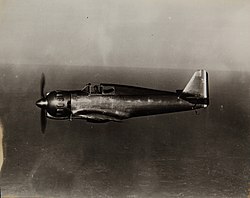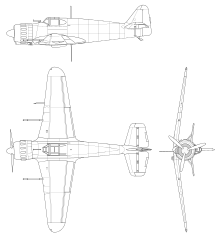Bloch MB.150
| Bloch MB.152 | |
|---|---|
 Bloch MB.151, 1939 |
|
| Type: | Fighter plane |
| Design country: |
France |
| Manufacturer: |
Société Nationale de Constructions Aéronautiques du Sud-Ouest |
| First flight: |
May 4, 1937 |
The Bloch MB.150 was a French fighter aircraft from 1937, following a tender issued by the French Air Force for a single-seater fighter in 1934 . Only a prototype of the Bloch MB.150 type was built, but it formed the basis for the Bloch MB.151, Bloch MB.152, Bloch MB.155 and Bloch MB.157 types, which were later built in larger numbers .
history
The Bloch MB.150 was Marcel Bloch's reaction to the specification "C1" published by the technical service of the Armée de l'air in 1934 for a light single-seat fighter aircraft . Although the Morane-Saulnier MS.406 was accepted for mass production early on, Marcel Bloch continued the development, which resulted in the prototype with the designation MB.150.01 in 1936 . The construction of the Société des Avions Marcel Bloch proved to be a failure and even failed when attempting to take off from the runway. After thorough improvements to structural (larger area) and chassis as well as the installation of a more powerful, 940 hp (701 kW ) paid Gnôme-Rhône 14N / 07 - radial engine with trilobal propeller rose the new prototype on 4 May 1937 its first flight was then transferred to the responsible inspection body of the Armée de l'air, the Center d'Essais du Materiel Aerien (CEMA) .
The CEMA found the type interesting enough to initiate further developments. This led to a further widening of the wings and the installation of the newer engine type 14N / 7 (also from Gnome-Rhône). In the spring of 1938, the SNCASO (in which Marcel Bloch's factory had merged due to the nationalization of the aviation industry ) finally ordered a pilot series of 25 MB.150s .
Since the construction turned out to be unsuitable for mass production, the pilot series was not produced. Instead, the type was revised again and on August 18, 1938, another prototype flew, this time equipped with a 14N / 35 engine and under the new designation Bloch MB.151 , of which finally 144 series copies for the fighter squadrons of the Armée de l'air were produced. The guy was with four 7.5-mm machine guns MAC-34 equipped.
Production was quickly converted in favor of the Bloch MB.152, which was developed in parallel, but suffered from delays in delivery of aircraft engines, armaments and propellers. This was equipped with a 1030 HP (757 kW) more powerful Gnome-Rhône-14N / 25 engine and more heavily armed with two 20-mm Hispano-Suiza HS-404 cannons instead of two of the MAC-34 machine guns. The MB.152 was 488 copies, the most produced of the MB.150 pattern derived.
The Bloch MB.153 was a further development of the MB.150 with a US Pratt & Whitney R-1830 Twin Wasp , but never went into series production. Only a prototype was completed, which was irreparably damaged in a crash. The Bloch MB.154 was designed as a similar version with a Wright R-1820 Cyclone engine, but was never built.
Instead, Bloch tried to improve the properties of the MB.152 , which led to the Bloch MB.155 with a Gnome Rhône 14N / 49 engine (1100 hp) and significantly better flight characteristics. The first flight of this version took place on December 3, 1939. Before the armistice in the Battle of France in 1940, 10 copies could be produced for the Armée de l'air. The 19 machines still in production were later completed for the Vichy Air Force with the permission of Germany .
The further development of the MB.155 culminated in the Bloch MB.157 . This version was equipped with a new, 1580 hp Gnome-Rhône 14R-4 "Météore" star engine under German supervision and achieved very good performance during the test flights in Orly in the spring of 1942. With a top speed of 710 km / h at an altitude of 7850 m, the machine demonstrated its capabilities. After the flights, the engine was dismantled and brought to Germany for test purposes, the fuselage of the machine was destroyed in 1943 by an Allied air raid in Orly.
commitment
The Bloch MB.151 and the Bloch MB.152 found their way into six Groupes de Chasse (GC) of the Armée de l'air . During the Battle of France in May and June 1940 within the Zone d'Operation Aériennes du Nord (ZOAN), the GC I / 1 , GC II / 1 and GC III / 10 were equipped with the MB.152 , while the GC I / 10 and GC II / 10 the MB.151 flew. Within the Zone d'Operation Aériennes de l'Est (ZOAE) the GC I / 8 and the GC II / 8 flew the MB.152 and the GC III / 9 flew the MB.151 . Although the machines turned out to be inferior to the German Messerschmitt Bf 109 in variant E, the kill rate of the French pilots was anything but bad: For every 84 lost aircraft (ten due to accidents), 150 were killed (35 of them probable) in the Time from May 10th to the armistice at the end of June. This statistic was led by the Groupe de Chasse I / 1 with 36 kills (four of them probable) .
The Air Force of Vichy-France used the remaining machines and the 29 copies of the MB.155 until it was disbanded. Some machines then found their way to Romania, where they were used against the Soviet Union.
A small series of nine MB.151 was delivered from France to Greece. There the machines fought against the air forces of Italy and Germany in 1941 with some success.
Bulgaria negotiated with the Vichy government to buy a small series of MB.152s . In February 1943, a contract for the delivery of 20 machines was signed, but the Germans, who meanwhile controlled the Vichy policy, prevented its realization. Instead, Bulgaria received a small batch of Dewoitine D.520 later in the year .
construction
The aircraft of the Bloch MB.150 series were low -wing aircraft in self-supporting all-metal construction with retractable landing gear and closed cockpit.
The series machines were equipped with radial engines Gnome-Rhône 14N , which produced a maximum output of 809 kW (1100 hp ). The power was delivered to a three-bladed controllable pitch propeller .
Technical specifications
| Parameter | Bloch MB.150.01 | Bloch MB.152C1 | Bloch MB.157.01 |
|---|---|---|---|
| crew | 1 | 1 | |
| length | 8.60 m | 9.10 m | 9.70 m |
| span | 10.30 m | 10.54 m | 10.70 m |
| height | 3.95 m | 3.20 m | |
| Wing area | 15.4 m² | 17.32 m² | 19.40 m² |
| Wing extension | 6.9 | 6.4 | 5.9 |
| Empty mass | 1700 kg | 2020 kg | 2390 kg |
| Takeoff mass | 2370 kg | 2750 kg | 3250 kg |
| Top speed | 434 km / h at 2600 m | 515 km / h at 4000 m | 710 km / h at 7850 m |
| Rate of climb | 10.75 m / s | ||
| Service ceiling | 10,000 m | ||
| Range | 600 km | 1095 km | |
| Engines | a Gnôme-Rhône 14N / 07 with 940 HP (approx. 690 kW) | a Gnome-Rhône 14N / 25 with 1,030 PS (approx. 760 kW) | a Gnome-Rhône 14R with 1,700 PS (approx. 1,250 kW) |
| Armament | two MG MAC 1934 M39, two 20mm Hispano-Suiza HS.404 cannons | ||
Countries of operation
See also
literature
- Dominique Breffort, André Jouineau, Alan McKay (translator): French Aircraft from 1939 to 1942 Volume 1: From ANF to Curtiss. Histoire & Collections, ISBN 2-915239-23-1 (English).
- Olaf Groehler : History of the Air War 1910 to 1980. Military Publishing House of the German Democratic Republic, Berlin 1981, p. 154.
- Kenneth Munson: The World War II Planes. Motorbuch-Verlag, Stuttgart 1999, ISBN 3-87943-302-X .
Web links
- Information about the MB.150 and derived types on www.aviafrance.com
- Page about the MB.152 at avions.legendaires.free.fr with data, plans, side plans and photos
- Bloch MB.151 C1 in the Greek Air Force 1939/40
Individual evidence
- ↑ cf. Olaf Groehler: History of the Air War 1910 to 1980. Military Publishing House of the German Democratic Republic, Berlin 1981, p. 154.
- ↑ Information on (un) used aircraft types in the Bulgarian Air Force on Aeroflight.co.uk


